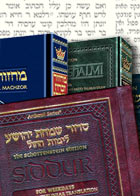ArtScroll, Inc.

Since its creation in 1976, the Orthodox publishing empire known as ArtScroll has brought out hundreds of titles: English translations of classic texts like the Bible, the siddur (prayer book), the Talmud, and others as well as self-help books, histories, biographies, fiction, and even cookbooks. All are marked by traditional scholarship, decent English, handsome and often innovative typography and graphics—and an unabashedly ultra-Orthodox (haredi) viewpoint. Advertised and marketed with acumen and zeal, ArtScroll has swept the English-speaking Orthodox world and made surprising inroads among non-Orthodox readers as well.
A newly published study, Orthodox by Design, provides the first scholarly investigation of the ArtScroll phenomenon and what it has to tell us about contemporary Judaism. According to the author, Jeremy Stolow, ArtScroll's success lies in its distinctive mix of authority, perceived authenticity, and accessibility. This is achieved not only through the volumes' content but through their user-friendly "design," in both the verbal and the visual sense. By making accessible to a wider public what are usually closed books, notably the siddur and, even more so, the Talmud, ArtsScroll has lowered the formidable barriers, social and linguistic, to identification with ultra-Orthodox Judaism; analogously, its biographies, histories, and self-help books have succeeded in reworking popular contemporary genres to fit ultra-Orthodox principles.
In keeping with its editors' views, ArtScroll simply ignores the existence of other versions of Orthodoxy, let alone of other religious denominations or of Zionism. Its history and biography series, which Stolow barely mentions, not only sanitizes the rabbinic past (often to the point of vapidity) but explicitly rewrites and censors the words of even unimpeachable authorities whose writings are out of step with contemporary haredi ideology.
Yet that ideology itself is far suppler than is often imagined. As Stolow argues, the very success of ArtScroll demonstrates that ultra-Orthodoxy, far from being an enclave subculture fighting a doomed, rearguard action against modernity, is a coherent worldview with the ability not only to absorb contemporary techniques of aesthetics, marketing, and production but, by means of these techniques, to offer religiously meaningful experiences to people living well outside the ambit of haredi life.
ArtScroll's success is of a piece with traditional Judaism's so-called "swing to the right" of recent years, and the corresponding decline in the authority and organizational power of the more avowedly modern Orthodox. Perhaps the most intriguing analysis of this development is that of the historian Haym Soloveitchik, who in a now-classic 1994 essay argued that modernity's fierce ruptures blasted away most of traditional society's amalgam of study, belief, folkways, and communal intimacy. Amid the ruins, the texts remained, yielding a formalist religion firmly in the sway of authoritarian talmudists whose stringencies offer a haven from the relentless instability of contemporary life.
The example of ArtScroll rings interesting changes on this idea. Yes, contemporary Orthodoxy is markedly book-centered; but a book is more than just the sum of its words. Presentation and style, physical heft and presence, the ways in which books are bought, displayed, chanted, or read, are all very much a part of the life and power of texts, sacred texts above all. Even, or precisely, in this disembodied digital age, the printed book still projects a distinctive aura and wields a distinctive influence.
Comments are closed for this article.




